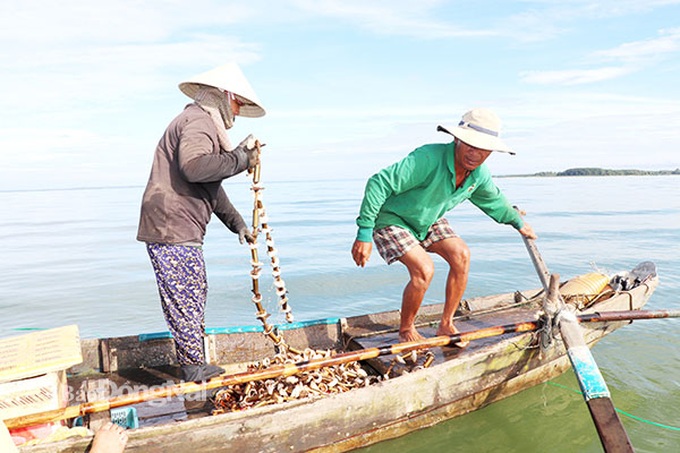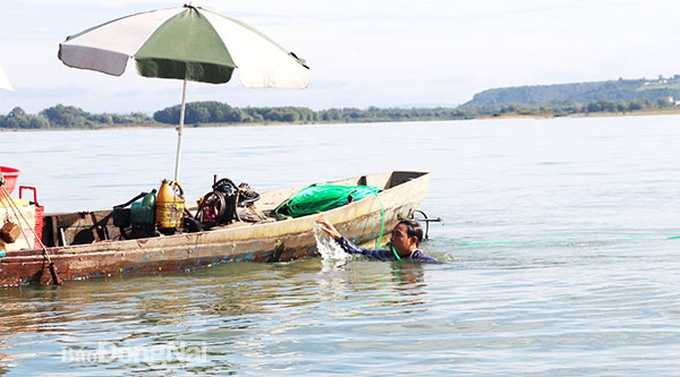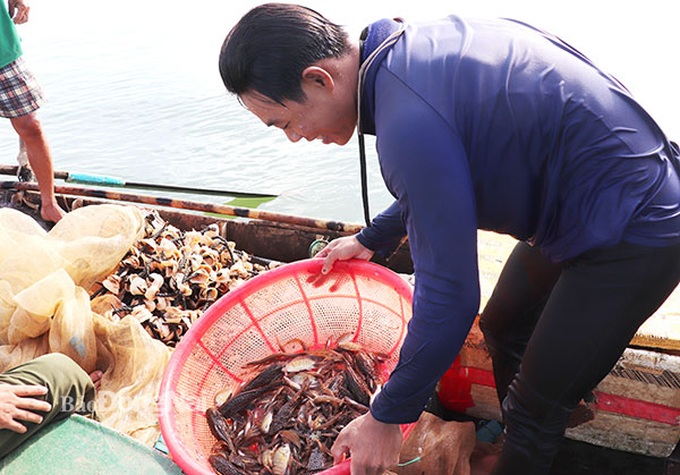Compass Travel Vietnam
Use seashells to chase the specialty fish of Tri An lake bed
Sand goby is considered one of the specialty fish of Tri An lake bed. Being favored by nature helps this fish grow and develop a lot. Since then, the fishing industry has been established and maintained up to now.

Goby fishing takes place all year round but is concentrated in the dry season. Although the work is hard because of the sun and rain at sea, even having to soak for hours in cold water to remove the nets, and collect fish… but this profession has created jobs, stable jobs, and guaranteed life. for dozens of fishing households living on Tri An lake bed.
Chasing the sand goblins
At 6 am, Ms. Le Thi Kim Thuy, her husband and son (living in Ben Nom 2 hamlet, Phu Cuong commune, Dinh Quan district) were present outside Tri An lake to prepare for a new day of catching sand goby. The place where Ms. Thuy’s family chooses to fish is the area near Phu Cuong Fishing Wharf (Phu Cuong Commune, Dinh Quan District).
Mr. Nguyen Van Tuan (ranger of the Mobile Ranger Group of Tri An Lake, Forest Protection Department of Dong Nai Nature – Culture Reserve) said that in addition to sand goby, Tri An lake also has a new type of coconut goby. appeared about a year ago. This fish is many times larger than the sand goby, eats well and reproduces, and thrives in Tri An Lake. Coconut goby is currently priced at 50,000 VND($2)/kg.
After carefully observing the lake surface to judge which areas are likely to have more gobies, Ms. Thuy’s family just started casting the first net. They used seashells (which were already woven into a long rope) to be dropped into the water to drive the sand goby into the net. Understanding our curiosity, Ms. Thuy explained, the sand goby often lives in schools at the bottom of the water, and whenever they see clams, oysters, snails, mussels, they run away. Taking advantage of this disadvantage, fishermen have long thought of a way to punch holes in the shells and then put them on the line, forming a scallop line about 100m long and then dropping the scallop line into the water in an arc. Then, use your hand to pull the scallop line to vibrate to make a noise to drive the goby to run into the net and catch.
“Gobies live on the bottom of the lake where there is a lot of gravel and sand, and when they hear the sound of shells, they will scare them and run into the net surrounding them. However, this species moves slowly in the water, requiring fishermen to catch fish. Goby fish must have experience, especially must be patient and hardworking. Anyone in a hurry can’t go fishing, because the fish will not enter the net “- Ms. Thuy shared.

After about 20 minutes of driving the gobies into the net, Ms. Thuy’s son began to hold a plastic tube to breathe oxygen into his mouth and then left the boat to dive into the deep water to remove objects entangled in the net (trees, reefs, etc.). …) and collect fish nets. On the boat, Ms. Thuy and her husband supported each other to pull up the net. The family’s first net harvest was not much, only about 1kg of sand goby. In addition, in the net, there are also some other fish species such as glass cleaner, copra, tilapia, etc.
While resting to prepare to release the next net, Ms. Thuy said that her family has been engaged in fishing for goby for more than 13 years. In the past, there were many sand goby fish in Tri An Lake, each day her family could catch 15-20kg of fish. However, the number of people involved in catching goby has increased in recent years, so the amount of fish harvested has also decreased significantly.
“On a lucky day, when they meet a large stream of fish, the family catches 10kg or more, and after deducting all expenses, there is still a profit of 500-600 thousand VND. But on a day when catching a few fish, from 4-6 kg, they only collect a profit. profit from 200-300 thousand dong… However, to make up for it, this profession is relatively stable, helping the family to have a secure job and a much better life than before” – Ms. Thuy confided. .($1=25, 000 VND)
Struggling to make a living
About 300m from the place where Ms. Thuy’s family fishes is the place of Mr. and Mrs. Nguyen Van Hoang (who lives in Ben Nom 2 hamlet, Phu Cuong commune, Dinh Quan district) who are also pulling nets to catch sand goby. Mr. Hoang and his wife were lucky enough to meet a large stream of fish, so after 2 times of pulling the net, they caught about 5kg of fresh fish. It is expected that by 11am, he and his wife will try to release 4 more nets in the hope of harvesting more than 10kg of fish to increase the family’s income.

According to Mr. Hoang, the work of catching goby is very hard and not everyone can do it. Those who follow this profession must ensure good health, because they have to spend many hours outdoors in the sun and rain, and even have to swim or dive deep in cold water to remove nets and collect fish.
“Many times when I dive to the bottom, I don’t look carefully, leading to bumps, hitting stumps or sharp bottles, causing punctures and bleeding. It’s so hard, but I’m used to the job anyway, moreover this profession. has brought the main source of income to support the whole family” – Mr. Hoang confided.
Mr. Hoang’s family is overseas Vietnamese and returned to Tri An lake bed to make a living since 2005. Returning to the country with empty hands, at first, he and his wife tried to work as hired laborers to earn a living. money for family living. In 2010, the couple decided to use their savings to buy boats and fishing gear for goby fishing.
Mr. Hoang confided: “Although the job sometimes encounters challenges, my family has managed to overcome and maintain the profession of catching goby fish for more than 12 years. Although this profession is hard and strenuous, has helped the family’s economy a lot better, has conditions to improve the quality of life and take care of their children’s education.”

As a person on duty on Tri An Lake for 26 years, Mr. Nguyen Van Tuan (ranger of the Tri An Lake Mobile Ranger Group, Dong Nai Nature – Culture Reserve Forest Protection Department) knows very well the properties of the lake. fish species as well as types of the fishery by fishermen on the lake bed. Mr. Tuan said that sand goby is one of the precious specialties and has been in Tri An lake for a long time (more than 15 years). This fish mainly lives in the Phu Cuong fishing wharf area, because it has many gravel and sand beaches and becomes an ideal environment for this species to grow and develop.
Currently, on Tri An lake, there are about 30 fishing households engaged in catching sand goby. This profession can take place all year round, but the main crop is concentrated in the dry season (from the end of last year to the first half of the next year). In the rainy season, when the lake water rises, the catch of sand goby is less.
“Adult gobies are about as big as the tip of a chopstick, their main food is small insects on the bottom of Tri An lake. At a time of scarcity, the price of sand goby can go up from 80- 100 thousand VND/kg, while the average price is stable from 40-60 thousand VND/kg. Currently, the price of goby fish is 60,000 VND/kg. Goby fishing has helped many households on the lake bed have a lot of work. get a job, so that you can overcome difficulties and stabilize your life” – Mr. Tuan shared.
Delicious dishes from the specialty of sand goby
Sand goby is considered a clean food, rich in nutrients. Sand goby has soft, sweet meat and can be used to process many delicious dishes that are loved by many people such as: braised tofu, braised with pepper, fried with fish sauce, fried with flour, cooked with sour soup…
According to Dong Nai Newspaper
Use seashells to chase the specialty fish of Tri An lake bed
vinlove.
Source: vinlove









